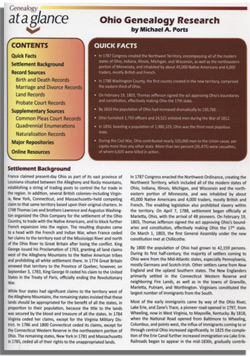 There is a new addition to the Genealogy At A Glance series: Ohio Genealogy Research, by Michael A. Ports.
There is a new addition to the Genealogy At A Glance series: Ohio Genealogy Research, by Michael A. Ports.As part of the Northwest Territory, Ohio was opened for settlement in 1787. Within a few years, when its boundaries were formally established, Ohio became the 17th state in the Union, with a population of about 50,000. By 1810 the population swelled to 230,000. After the development of the National Road and the Erie Canal, the original settlers from the mid-Atlantic states (mostly Pennsylvania-Germans and Scotch-Irish), were joined by Irish and German immigrants, expanding the population to 2 million. The records left by these early settlers and immigrants can be found in county courthouses from Washington County (created in 1791) to Noble County (created in 1851), though most of them are centralized under the Ohio Network of American History Research Centers, positioned geographically around the largest metropolitan areas and coordinated by the Ohio History Center in Columbus.
Ohio Genealogy Research provides the basic historical facts and list of resources any family historian can use to further research for their Ohioan ancestors. Like all the Genealogy At A Glance sheets, this guide is a four-page, full-color laminated brochure, meant to be easily stored and sized to take with you when conducting related research. In this guide, Larson provides plenty of additional tips and further references to please the most avid researcher.
Contents for this guide:
Quick Facts
Settlement Background
Record Sources
Birth and Death Records
Marriage and Divorce Records
Land Records
Probate Court Records
Supplementary Source
Common Pleas Court Records
Quandrennial Enumeration
Naturalization Records
Major Repositories
Online Resources
Order Genealogy at a Glance: Ohio Genealogy Research from Family Roots Publishing.